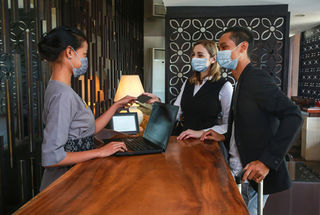Four Interior Design Trends for the Post-Pandemic Hotel

Once the greenlight was given, all businesses looked to reopen as quickly as possible after the lockdown. This has resulted in countless slapdash efforts for achieving the minimum of viral safety compliance, with most structural upgrades meant as only temporary installations and most of them particularly garish at that. As is becoming increasingly apparent, though, COVID-19 is here to stay and thus so too are the new measures that have been put in place.
The problem is that most, if not all, of the provisional objects and signage implemented in the wake of the pandemic look just plain hideous when bolted onto well-designed indoor hotel spaces. While all is well and good during patio season as most customers will remain outside, our current lobbies and public interiors in the age of COVID do not create environments that people actually want to spend time in. Come autumn and winter, this can mean decreased F&B revenues and lower overall guest satisfaction as all visitors won't feel warm and cozy amidst so much gaudy viral safety mania.
You don't want your lobby or restaurants to look abandoned as a result of people not lingering about; you want to facilitate lively atmospheres that customers are attracted. This requires some creativity from seasoned interior designers who can find opportunities within the adversity arising from COVID.
Hence, I turned to my fellow Torontonian, Danny SC Tseng, the Development Director at Syllable, a bespoke architecture and interior design firm that has been working overtime since March to help clients address viral safety obligations while also making spaces palatable to the passerby. A trained architect himself, Danny offer four poignant trends to consider when upgrading a hotel's interior with permanent structures that are engaging yet also COVID-compliant.
Trend #1: Experiential Hygiene
By reframing hygiene as an experience, there is an opportunity to elevate the mere act of sanitization as a hospitality rite similar to how Hawaiians imbue a strong sense of place by greeting new guests with fresh flower leis and a cheerful "Aloha!" Consider the automatic hand-sanitizing dispensers placed near the entrance for visitors to disinfect their hands, whereby the perfunctory act of administering rubbing alcohol can be rebranded as a ritualistic experience which also informs visitors that they are entering a safe and rejuvenating space.
Designed to resemble spa counters, 'Cleansing Bars' can be placed near high-traffic areas to promote cleanliness. Within the suites themselves, UV sterilizer cabinets for disinfecting keys and walls can be intentionally built within closets as a design feature to offer guests greater peace of mind. Furthermore, essential oils, like tea tree oil, are effective as antibacterial and antiviral agents. Since scent is more closely tied to memory than any other of the five senses, hotels can produce their own essential oil blends to take advantage of this olfactory connection to link the scent to the guest's memory of staying at the hotel.
Trend #2: Natural Materiality
Viruses can transfer through the contact of exposed surfaces, making high-contact objects and areas dangerous. Hotels can incorporate materials that inherently eliminate germs in high-traffic areas prone to exposure. COVID has been noted to survive for up to three days on plastic and stainless-steel surfaces, while dying within four hours on copper and its alloys such as brass or bronze. Cork is another antibacterial material used as a material finish. Additionally, scientists are also exploring biomimicry to create altered textures that can be etched on surfaces and help keep contaminates at bay, similar to the epithelial qualities of cicada wings and lotus leaves.
Trend #3: Branded Wayfinding
There's still an untapped opportunity for hotels to create a branded, and thus emotional impactful, experience using signage and wayfinding elements. In addition to helping people navigate, wayfinding visuals can incorporate uplifting messages that aligns with the brand's values.
Signage can be crafted to express the brand's personality through colors and designs that complement a space while engaging with visitors, perhaps using such playful messaging like, 'No Mask, No Service' or 'Mask on for the Masquerade'. Friendly and fun, these taglines help guide the visitor's journey and communicate that we are all still human. As another example, instead of writing, 'Keep six feet apart', use the cheeky phrase, 'Please admire fellow patrons from afar'.
Trend #4: Protective Shield Design
Screens have been used for centuries as a design feature to define spaces and create privacy. Generic clear Plexiglass as a viral barrier can make visitors feel like they're visiting an inmate in prison. Hotels should therefore consider layering decorative screens with Plexiglass as a graphical design component to visually elevate larger open spaces and create pockets of privacy between patrons. Decorative architectural panels can also help dictate movement to help manage guest traffic flow. Additionally, inlays within each screen can also house wayfinding signage or even sponsored advertisements, acting as both a protective shield and billboard.

